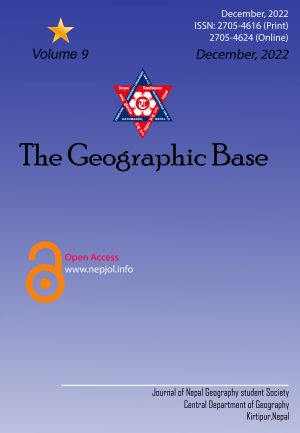Effect of Urbanization on Land Surface Temperature: A Case Study of Kathmandu Valley
DOI:
https://doi.org/10.3126/tgb.v9i1.55427Keywords:
Urban development, Kathmandu Valley, Land use land cover (LULC), Land Surface Temperature (LST)Abstract
Growth in the population over time is bound to increase the expansion of densely populated areas which will change the dynamics of land use and land cover (LULC) directly or indirectly. The objective of this study is to analyze the effect of urban growth on the land surface temperature (LST) in Kathmandu. We used the maximum likelihood classification method for LULC classification and change detection of pre-monsoon satellite data for the years 2000, 2005, 2010, 2015 and 2020. LST was then calculated using the thermal infrared band from the satellite imagery. Finally, the relationship between urban growth and LST was assessed by correlation and regression analysis. The result shows an increase in urban areas by 241.61% of the total area between 2000 and 2020. The analysis of thermal patterns shows that there is a gradual increase in temperature in the urban area. With an overall accuracy of 89.96% and a Kappa coefficient of 0.86, the study shows high agreement between classified data from images. This study shows that urbanization has a significant positive impact on average land surface temperature. Sustainable city planning and strict adherence to the Land Use Act and regulations will assist to make the urbanization process more sustainable in the future.
Downloads
Downloads
Published
How to Cite
Issue
Section
License
© Nepal Geography Student Society




